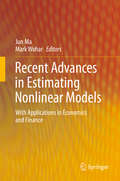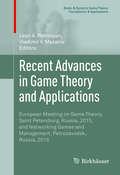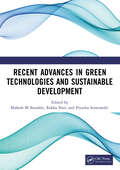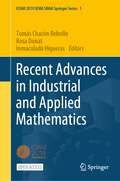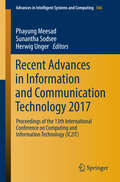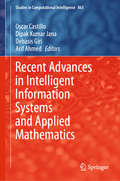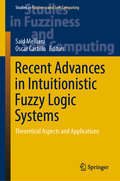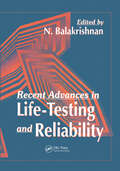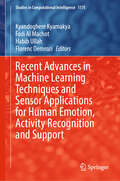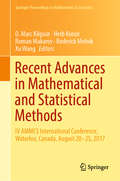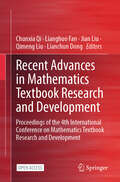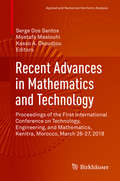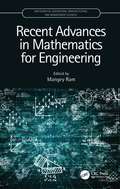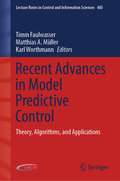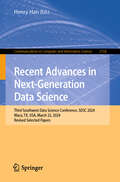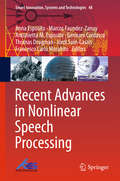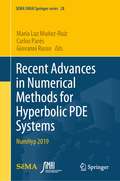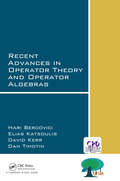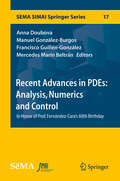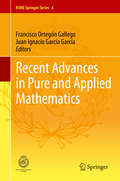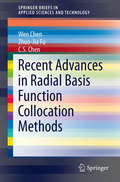- Table View
- List View
Recent Advances in Engineering Mathematics and Physics: Proceedings of the International Conference RAEMP 2019
by Mohamed Hesham Farouk Maha Amin HassaneinThis book gathers the proceedings of the 4th conference on Recent Advances in Engineering Math. & Physics (RAEMP 2019), which took place in Cairo, Egypt in December 2019. This international and interdisciplinary conference highlights essential research and developments in the field of Engineering Mathematics and Physics and related technologies and applications. The proceedings is organized to follow the main tracks of the conference: Advanced computational techniques in engineering and sciences; computational intelligence; photonics; physical measurements and big data analytics; physics and nano-technologies; and optimization and mathematical analysis.
Recent Advances in Estimating Nonlinear Models
by Jun Ma Mark WoharNonlinear models have been used extensively in the areas of economics and finance. Recent literature on the topic has shown that a large number of series exhibit nonlinear dynamics as opposed to the alternative--linear dynamics. Incorporating these concepts involves deriving and estimating nonlinear time series models, and these have typically taken the form of Threshold Autoregression (TAR) models, Exponential Smooth Transition (ESTAR) models, and Markov Switching (MS) models, among several others. This edited volume provides a timely overview of nonlinear estimation techniques, offering new methods and insights into nonlinear time series analysis. It features cutting-edge research from leading academics in economics, finance, and business management, and will focus on such topics as Zero-Information-Limit-Conditions, using Markov Switching Models to analyze economics series, and how best to distinguish between competing nonlinear models. Principles and techniques in this book will appeal to econometricians, finance professors teaching quantitative finance, researchers, and graduate students interested in learning how to apply advances in nonlinear time series modeling to solve complex problems in economics and finance.
Recent Advances in Game Theory and Applications
by Leon A. Petrosyan Vladimir V. MazalovThis contributed volume contains fourteen papers based on selected presentations from the European Conference on Game Theory SING11-GTM 2015, held at Saint Petersburg State University in July 2015, and the Networking Games and Management workshop, held at the Karelian Research Centre of the Russian Academy of Sciences in Petrozvavodsk, Russia, also in July 2015. These papers cover a wide range of topics in game theory, including recent advances in areas with high potential for future work, as well as new developments on classical results. Some of these include A new approach to journal ranking using methods from social choice theory; A differential game of a duopoly in which two firms are competing for market share in an industry with network externalities; The impact of information propagation in the model of tax audits; A voting model in which the results of previous votes can affect the process of coalition formation in a decision-making body; The Selten-Szidarovsky technique for the analysis of Nash equilibria of games with an aggregative structure; Generalized nucleoli and generalized bargaining sets for games with restricted cooperation; Bayesian networks and games of deterrence; and A new look at the study of solutions for games in partition function form. The maturity and vitality of modern-day game theory are reflected in the new ideas, novel applications, and contributions of young researchers represented in this collection. It will be of interest to anyone doing theoretical research in game theory or working on one its numerous applications.
Recent Advances in Green Technologies and Sustainable Development
by Rekha Nair Piyusha Somvanshi Mahesh M BundeleRecent advances in green technologies and sustainable development deals with cutting-edge research and innovative ideas in different categories of green technologies and operational aspects of sustainable development including renewable energy sources, power systems, mathematical ecol□ogy, industrial technologies, construction and material sciences. The chapters are written by eminent and insightful authors to propose improvement and expansion of processes and applications connected to sustainable development. Environmental awareness and protection are one of the challenging issues of the new millennia. Industrialization and population explosion has opened new frontiers in the conservation of environmental protection. Rapid urbanization is proving to have direct consequences on the environment. The need of the hour is a balanced approach to multi layered conservative methods. Any sustainable devel□opment has a multifaceted approach, encompassing environmental, tech□nological, social, and economical developmental dimensions. This book focuses on these various issues in a progressive manner. The selected papers in this book have highlighted a plethora of issues related to green technology and sustainable development. Ample care has been given to selecting the papers which tried to bridge the gap between technological advancement and its impact on the environment.
Recent Advances in Hodge Theory: Period Domains, Algebraic Cycles, and Arithmetic
by Matt Kerr Gregory PearlsteinIn its simplest form, Hodge theory is the study of periods – integrals of algebraic differential forms which arise in the study of complex geometry and moduli, number theory and physics. Organized around the basic concepts of variations of Hodge structure and period maps, this volume draws together new developments in deformation theory, mirror symmetry, Galois representations, iterated integrals, algebraic cycles and the Hodge conjecture. Its mixture of high-quality expository and research articles make it a useful resource for graduate students and seasoned researchers alike.
Recent Advances in Industrial and Applied Mathematics (SEMA SIMAI Springer Series #1)
by Inmaculada Higueras Tomás Chacón Rebollo Rosa DonatThis open access book contains review papers authored by thirteen plenary invited speakers to the 9th International Congress on Industrial and Applied Mathematics (Valencia, July 15-19, 2019). Written by top-level scientists recognized worldwide, the scientific contributions cover a wide range of cutting-edge topics of industrial and applied mathematics: mathematical modeling, industrial and environmental mathematics, mathematical biology and medicine, reduced-order modeling and cryptography. The book also includes an introductory chapter summarizing the main features of the congress. This is the first volume of a thematic series dedicated to research results presented at ICIAM 2019-Valencia Congress.
Recent Advances in Information and Communication Technology 2017
by Phayung Meesad Herwig Unger Sunantha SodseeThis book includes selected contributions related to big data and data networking, presented at the 13th International Conference on Computing and Information Technology (IC2IT), which was held at the Arnoma Grand Hotel Bangkok, Thailand, July 6-7, 2017. The aim of the conference was to present emerging algorithms, methods and technologies with a high degree of originality, novelty and innovation addressing the conference theme `Mastering Data and Networking'. Section 1 and 2 discuss various aspects of data mining and corresponding applications. Section 3 focuses on speed and overhead networking optimisation problems, as well as energy problems of autonomous systems, which are becoming increasingly important. The key to addressing these problems is properly determining critical parameters. Section 4 sheds light on natural language processing, including extraction of trends and popularity and recognition of emotions as well as classic topics such as detection and classification.
Recent Advances in Intelligent Information Systems and Applied Mathematics (Studies in Computational Intelligence #863)
by Arif Ahmed Oscar Castillo Debasis Giri Dipak Kumar JanaThis book describes the latest advances in intelligent techniques such as fuzzy logic, neural networks, and optimization algorithms, and their relevance in building intelligent information systems in combination with applied mathematics. The authors also outline the applications of these systems in areas like intelligent control and robotics, pattern recognition, medical diagnosis, time series prediction, and optimization of complex problems. By sharing fresh ideas and identifying new targets/problems it offers young researchers and students new directions for their future research. The book is intended for readers from mathematics and computer science, in particular professors and students working on theory and applications of intelligent systems for real-world applications.
Recent Advances in Intuitionistic Fuzzy Logic Systems: Theoretical Aspects and Applications (Studies in Fuzziness and Soft Computing #372)
by Oscar Castillo Said MellianiThis book aims at providing an overview of state-of-the-art in both the theory and methods of intuitionistic fuzzy logic, partial differential equations and numerical methods in informatics. It covers topics such as fuzzy intuitionistic Hilbert spaces, intuitionistic fuzzy differential equations, fuzzy intuitionistic metric spaces, and numerical methods for differential equations. It reports on applications such as fuzzy real time scheduling, intelligent control, diagnostics and time series prediction. Chapters were carefully selected among contributions presented at the second edition of the International Conference on Intuitionistic Fuzzy Sets and Mathematical Science, ICIFSMAS, held on April 11-13, 2018, at Al Akhawayn University of Ifrane, in Morocco.
Recent Advances in Life-Testing and Reliability
by N. BalakrishnanThis unique volume presents chapters written on the areas of life-testing and reliability by many well-known researchers who have contributed significantly to these two areas over the years. Chapters cover a wide range of topics such as inference under censoring and truncation, reliability growth models, designs to improve quality, prediction techniques, Bayesian analysis of reliability, multivariate methods, accelerated testing, and more. The book is written in an easy-to-follow style, first presenting the necessary theoretical details and then illustrating the methods with a numerical examples wherever possible. Many tables and graphs that are essential for the use of some of the new methodologies are presented throughout the volume. Numerous examples provide the reader with a clear understanding of the methods presented as well as with insight into the applications of these results.
Recent Advances in Machine Learning Techniques and Sensor Applications for Human Emotion, Activity Recognition and Support (Studies in Computational Intelligence #1175)
by Kyandoghere Kyamakya Fadi Al Machot Habib Ullah Florenc DemroziThis book explores integrating machine learning techniques and sensor applications for human emotion and activity recognition, creating personalized and effective support systems. It covers state-of-the-art machine learning techniques and large language models using multimodal sensors. Enhancing the quality of life for individuals with special needs, particularly the elderly, is a key focus in Active and Assisted Living (AAL) research. Unlike other literature, it emphasizes support mechanisms along with recognition, using metamodel integration for adaptable AAL systems. This book offers insights into technologies transforming AAL for researchers, students, and practitioners. It is a valuable resource for developing responsive and personalized support systems that enhance life quality in smart environments. It is also essential for advancing the understanding of machine learning and sensor technologies in AAL and emotion recognition.
Recent Advances in Mathematical Sciences
by Hari M. Srivastava M. Mursaleen Adem Kılıçman Zanariah Abdul MajidThis book features selected papers from The Seventh International Conference on Research and Education in Mathematics that was held in Kuala Lumpur, Malaysia from 25 - 27th August 2015. With chapters devoted to the most recent discoveries in mathematics and statistics and serve as a platform for knowledge and information exchange between experts from academic and industrial sectors, it covers a wide range of topics, including numerical analysis, fluid mechanics, operation research, optimization, statistics and game theory. It is a valuable resource for pure and applied mathematicians, statisticians, engineers and scientists, and provides an excellent overview of the latest research in mathematical sciences.
Recent Advances in Mathematical and Statistical Methods: Iv Ammcs International Conference, Waterloo, Canada, August 20-25 2017 (Springer Proceedings in Mathematics & Statistics #259)
by Roderick Melnik D. Marc Kilgour Herb Kunze Roman Makarov Xu WangThis book focuses on the recent development of methodologies and computation methods in mathematical and statistical modelling, computational science and applied mathematics. It emphasizes the development of theories and applications, and promotes interdisciplinary endeavour among mathematicians, statisticians, scientists, engineers and researchers from other disciplines. The book provides ideas, methods and tools in mathematical and statistical modelling that have been developed for a wide range of research fields, including medical, health sciences, biology, environmental science, engineering, physics and chemistry, finance, economics and social sciences. It presents original results addressing real-world problems. The contributions are products of a highly successful meeting held in August 2017 on the main campus of Wilfrid Laurier University, in Waterloo, Canada, the International Conference on Applied Mathematics, Modeling and Computational Science (AMMCS-2017). They make this book a valuable resource for readers interested not only in a broader overview of the methods, ideas and tools in mathematical and statistical approaches, but also in how they can attain valuable insights into problems arising in other disciplines.
Recent Advances in Mathematics Textbook Research and Development: Proceedings of the 4th International Conference on Mathematics Textbook Research and Development
by Lianghuo Fan Chunxia Qi Jian Liu Qimeng Liu Lianchun DongThis open-access book documents the issues and developments in mathematics textbook research as presented at the Fourth International Conference on Mathematics Textbook Research and Development (ICMT 4), held at Beijing Normal University (China) in November 2022. It showcases research and practical experiences from the mathematics textbook research field from over 20 countries and reflects the current trend of curriculum reform globally in terms of mathematics textbook research. It helps readers gain knowledge about various issues related to the development, content and use of mathematics textbooks from kindergarten to university level, in and out of school settings, in paper or digital format, as well as the historical and recent developments and future directions in mathematics textbook research. ICMT 4 continues the successful series started in 2014, with the first ICMT held in Southampton (UK), which was followed in 2017 by ICMT 2 in Rio de Janeiro (Brazil) and in 2019 by ICMT 3 in Paderborn (Germany).
Recent Advances in Mathematics and Technology: Proceedings of the First International Conference on Technology, Engineering, and Mathematics, Kenitra, Morocco, March 26-27, 2018 (Applied and Numerical Harmonic Analysis)
by Kasso A. Okoudjou Serge Dos Santos Mostafa MaslouhiThe chapters in this volume are based on talks given at the inaugural Technology, Engineering and Mathematics Conference (TEM18), held from March 26 to 27, 2018 in Kenitra, Morocco. Advances in mathematical modeling, optimization, numerical analysis, signal processing, and computer science are presented by leading experts in these fields. There is a particular emphasis on stochastic analysis, machine learning algorithms, and deep learning models, which are highly relevant to the state-of-the-art in augmented, virtual, and mixed realities. Topics include:Harmonic analysisBig data analytics and applicationsBiomathematicsComputer engineering and applicationsEconomics and financial engineeringMedical imaging and non-destructive testingThis volume is ideal for engineers and researchers working in technological fields that need to be modeled and simulated using the tools of modern mathematics.
Recent Advances in Mathematics for Engineering (Mathematical Engineering, Manufacturing, and Management Sciences)
by Mangey RamIn recent years, mathematics has experienced amazing growth in the engineering sciences. Mathematics forms the common foundation of all engineering disciplines. This book provides a comprehensive range of mathematics applied in various fields of engineering for different tasks such as civil engineering, structural engineering, computer science, and electrical engineering, among others. It offers chapters that develop the applications of mathematics in engineering sciences, conveys the innovative research ideas, offers real-world utility of mathematics, and has a significance in the life of academics, practitioners, researchers, and industry leaders. Features Focuses on the latest research in the field of engineering applications Includes recent findings from various institutions Identifies the gaps in the knowledge in the field and provides the latest approaches Presents international studies and findings in modeling and simulation Offers various mathematical tools, techniques, strategies, and methods across different engineering fields
Recent Advances in Mechanics and Fluid-Structure Interaction with Applications: The Bong Jae Chung Memorial Volume (Advances in Mathematical Fluid Mechanics)
by Fernando Carapau Ashwin VaidyaThis volume examines current research in mechanics and its applications to various disciplines, with a particular focus on fluid-structure interaction (FSI). The topics have been chosen in commemoration of Dr. Bong Jae Chung and with respect to his wide range of research interests. This volume stands apart because of this diversity of interests, featuring an interdisciplinary and in-depth analysis of FSI that is difficult to find conveniently collected elsewhere in the literature. Contributors include mathematicians, physicists, mechanical and biomechanical engineers, and psychologists. This volume is structured into four thematic areas in order to increase its accessibility: theory, computations, experiments, and applications. Recent Advances in Mechanics and Fluid-Structure Interaction with Applications will appeal to established researchers as well as postdocs and graduate students interested in this active area of research.
Recent Advances in Model Predictive Control: Theory, Algorithms, and Applications (Lecture Notes in Control and Information Sciences #485)
by Karl Worthmann Timm Faulwasser Matthias A. MüllerThis book focuses on distributed and economic Model Predictive Control (MPC) with applications in different fields. MPC is one of the most successful advanced control methodologies due to the simplicity of the basic idea (measure the current state, predict and optimize the future behavior of the plant to determine an input signal, and repeat this procedure ad infinitum) and its capability to deal with constrained nonlinear multi-input multi-output systems. While the basic idea is simple, the rigorous analysis of the MPC closed loop can be quite involved. Here, distributed means that either the computation is distributed to meet real-time requirements for (very) large-scale systems or that distributed agents act autonomously while being coupled via the constraints and/or the control objective. In the latter case, communication is necessary to maintain feasibility or to recover system-wide optimal performance. The term economic refers to general control tasks and, thus, goes beyond the typically predominant control objective of set-point stabilization. Here, recently developed concepts like (strict) dissipativity of optimal control problems or turnpike properties play a crucial role.The book collects research and survey articles on recent ideas and it provides perspectives on current trends in nonlinear model predictive control. Indeed, the book is the outcome of a series of six workshops funded by the German Research Foundation (DFG) involving early-stage career scientists from different countries and from leading European industry stakeholders.
Recent Advances in Next-Generation Data Science: Third Southwest Data Science Conference, SDSC 2024, Waco, TX, USA, March 22, 2024, Revised Selected Papers (Communications in Computer and Information Science #2158)
by Henry HanThis book constitutes the refereed proceedings of the Third Southwest Data Science Conference, on Recent advances in next-generation data science, SDSC 2024, held in Waco, TX, USA, in March 22, 2024. The 15 full papers presented were carefully reviewed and selected from 59 submissions. These papers focus on AI security in next-generation data science and address a range of challenges, from protecting sensitive data to mitigating adversarial threats.
Recent Advances in Nonlinear Speech Processing
by Anna Esposito Marcos Faundez-Zanuy Antonietta M. Esposito Gennaro Cordasco Thomas Drugman Jordi Solé-Casals Francesco Carlo MorabitoThis book presents recent advances in nonlinearspeech processing beyond nonlinear techniques. It shows that it exploitsheuristic and psychological models of human interaction in order to succeed inthe implementations of socially believable VUIs and applications for humanhealth and psychological support. The book takes into account themultifunctional role of speech and what is "outside of the box" (see BjörnSchuller's foreword). To this aim, the book is organized in 6 sections, eachcollecting a small number of short chapters reporting advances "inside" and"outside" themes related to nonlinear speech research. The themes emphasizetheoretical and practical issues for modelling socially believable speechinterfaces, ranging from efforts to capture the nature of sound changes inlinguistic contexts and the timing nature of speech; labors to identify anddetect speech features that help in the diagnosis of psychological and neuronaldisease, attempts to improve the effectiveness and performance of Voice UserInterfaces, new front-end algorithms for the coding/decoding of effective andcomputationally efficient acoustic and linguistic speech representations, aswell as investigations capturing the social nature of speech in signalingpersonality traits, emotions and improving human machine interactions.
Recent Advances in Numerical Methods for Hyperbolic PDE Systems: NumHyp 2019 (SEMA SIMAI Springer Series #28)
by Carlos Parés Giovanni Russo María Luz Muñoz-RuizThe present volume contains selected papers issued from the sixth edition of the International Conference "Numerical methods for hyperbolic problems" that took place in 2019 in Málaga (Spain). NumHyp conferences, which began in 2009, focus on recent developments and new directions in the field of numerical methods for hyperbolic partial differential equations (PDEs) and their applications. The 11 chapters of the book cover several state-of-the-art numerical techniques and applications, including the design of numerical methods with good properties (well-balanced, asymptotic-preserving, high-order accurate, domain invariant preserving, uncertainty quantification, etc.), applications to models issued from different fields (Euler equations of gas dynamics, Navier-Stokes equations, multilayer shallow-water systems, ideal magnetohydrodynamics or fluid models to simulate multiphase flow, sediment transport, turbulent deflagrations, etc.), and the development of new nonlinear dispersive shallow-water models. The volume is addressed to PhD students and researchers in Applied Mathematics, Fluid Mechanics, or Engineering whose investigation focuses on or uses numerical methods for hyperbolic systems. It may also be a useful tool for practitioners who look for state-of-the-art methods for flow simulation.
Recent Advances in Operator Theory and Operator Algebras: Xixth International Conference On Operator Theory, Timisoara (romania) 2002 (Operator Theory: Advances And Applications Ser. #153)
by David Kerr Hari Bercovici Elias Katsoulis Dan TimotinThis book will contain lectures given by four eminent speakers at the Recent Advances in Operator Theory and Operator Algebras conference held at the Indian Statistical Institute, Bangalore, India in 2014. The main aim of this book is to bring together various results in one place with cogent introduction and references for further study.
Recent Advances in PDEs: In Honor Of Prof. Fernández-cara's 60th Birthday (SEMA SIMAI Springer Series #17)
by Anna Doubova Manuel González-Burgos Francisco Guillén-González Mercedes Marín BeltránThis book contains the main results of the talks given at the workshop “Recent Advances in PDEs: Analysis, Numerics and Control”, which took place in Sevilla (Spain) on January 25-27, 2017. The work comprises 12 contributions given by high-level researchers in the partial differential equation (PDE) area to celebrate the 60th anniversary of Enrique Fernández-Cara (University of Sevilla). The main topics covered here are: Control and inverse problems, Analysis of Fluid mechanics and Numerical Analysis. The work is devoted to researchers in these fields.
Recent Advances in Pure and Applied Mathematics (RSME Springer Series #4)
by Francisco Ortegón Gallego Juan Ignacio García GarcíaThis volume comprises high-quality works in pure and applied mathematics from the mathematical communities in Spain and Brazil. A wide range of subjects are covered, ranging from abstract algebra, including Lie algebras, commutative semigroups, and differential geometry, to optimization and control in real world problems such as fluid mechanics, the numerical simulation of cancer PDE models, and the stability of certain dynamical systems. The book is based on contributions presented at the Second Joint Meeting Spain-Brazil in Mathematics, held in Cádiz in December 2018, which brought together more than 330 delegates from around the world. All works were subjected to a blind peer review process. The book offers an excellent summary of the recent activity of Spanish and Brazilian research groups and will be of interest to researchers, PhD students, and graduate scholars seeking up-to-date knowledge on these pure and applied mathematics subjects.
Recent Advances in Radial Basis Function Collocation Methods
by Wen Chen Zhuo-Jia Fu C. S. ChenThis book surveys the latest advances in radial basis function (RBF) meshless collocation methods which emphasis on recent novel kernel RBFs and new numerical schemes for solving partial differential equations. The RBF collocation methods are inherently free of integration and mesh, and avoid tedious mesh generation involved in standard finite element and boundary element methods. This book focuses primarily on the numerical algorithms, engineering applications, and highlights a large class of novel boundary-type RBF meshless collocation methods. These methods have shown a clear edge over the traditional numerical techniques especially for problems involving infinite domain, moving boundary, thin-walled structures, and inverse problems. Due to the rapid development in RBF meshless collocation methods, there is a need to summarize all these new materials so that they are available to scientists, engineers, and graduate students who are interest to apply these newly developed methods for solving real world's problems. This book is intended to meet this need. Prof. Wen Chen and Dr. Zhuo-Jia Fu work at Hohai University. Prof. C. S. Chen works at the University of Southern Mississippi.

